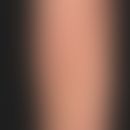Synonym(s)
HistoryThis section has been translated automatically.
DefinitionThis section has been translated automatically.
Acquired longitudinal channel-like notch that extends from the matrix to the edge of the nail. It affects both males and females.
You might also be interested in
EtiopathogenesisThis section has been translated automatically.
It is assumed that median nail dystrophy is mostly triggered by trauma (habitual ticks) or inflammation. In this case, there are localized defects in the matrix area with consecutive, longitudinal damage to the nail plate. The clinical picture can also be triggered by drugs (e.g. ritonavir). Familiarity has been described (Sweeney SA et al. 2005).
LocalizationThis section has been translated automatically.
Most often localized on the thumb. One nail or several nails may be affected.
Clinical featuresThis section has been translated automatically.
Longitudinal striate nail dystrophy with irregular tub-like depressions. Median nail dystrophy is often symmetrical and most commonly affects the thumbs (Khodaee M et al. 2020).
Differential diagnosisThis section has been translated automatically.
Common differential diagnoses for longitudinal nail defects include tic deformity, subungual skin tumors, digital mucous cysts, and trachyonychia (rough nails). To rule out onychomycosis, testing with a potassium hydroxide or optical fluorescence preparation or a fungal culture is recommended. Lichen planus is unlikely in the absence of other skin or mucosal lesions. Nail splits associated with lichen planus are usually irregular and not typically associated with grooves or macrolunules.
TherapyThis section has been translated automatically.
Although median nail dystrophy has been treated with topical corticosteroids, tacrolimus, and tazarotene, there is little convincing evidence that nail changes can be reversed (Khodaee M et al. 2020). If artificially triggered, psychiatric treatment (see artifacts below).
LiteratureThis section has been translated automatically.
- Borges-Costa J et al (2013) Median nail dystrophy associated with ritonavir. Int J Dermatol 52:1581-158
- Khodaee M et al (2020) Median nail dystrophy. CMAJ 192(50):E1810.
- Kota R et al (2016) Median nail dystrophy Involving the thumb nail. Indian J Dermatol 61:120.
- Sweeney SA et al (2005) Familial median canaliform nail dystrophy. Cutis 75:161-165
- Verma SB (2008) Glomus tumor-induced longitudinal splitting of nail mimicking median canaliform dystrophy. Indian J Dermatol Venereol Leprol 74:257-259.
Incoming links (4)
Dysonychia; Dystrophia ungium mediana canaliformis; Infantile T-cell lymphopenia with or without nail dystrophy; Nail gap;Outgoing links (1)
Artifacts;Disclaimer
Please ask your physician for a reliable diagnosis. This website is only meant as a reference.






